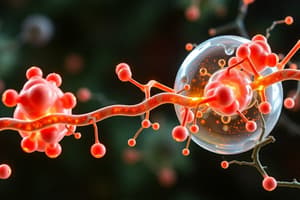Podcast
Questions and Answers
What role does ATP play in cellular processes?
What role does ATP play in cellular processes?
- It stores and provides energy for cellular functions. (correct)
- It serves as a genetic material for cells.
- It acts as a structural component of cells.
- It helps in the formation of cellular membranes.
Where is ATP synthase primarily located in eukaryotic cells?
Where is ATP synthase primarily located in eukaryotic cells?
- Ribosomes
- Cytoplasm
- Nucleus
- Mitochondria (correct)
Which component of ATP synthase is driven by the proton motive force?
Which component of ATP synthase is driven by the proton motive force?
- F0 motor (correct)
- F1 motor
- Central stalk
- Peripheral stalk
What are the three distinct states that the F1 motor's catalytic subunits cycle through during ATP synthesis?
What are the three distinct states that the F1 motor's catalytic subunits cycle through during ATP synthesis?
How does the dimerization of ATP synthase affect the inner mitochondrial membrane?
How does the dimerization of ATP synthase affect the inner mitochondrial membrane?
What happens to ATP after the cleavage of the last phosphate group?
What happens to ATP after the cleavage of the last phosphate group?
What is the main function of the central stalk in ATP synthase?
What is the main function of the central stalk in ATP synthase?
Why is the peripheral stalk considered dynamic in ATP synthase?
Why is the peripheral stalk considered dynamic in ATP synthase?
Flashcards
What is ATP?
What is ATP?
The universal biological fuel used by all living organisms. Stores chemical energy in high-energy phosphate bonds.
What is the structure of ATP?
What is the structure of ATP?
ATP consists of an adenosine molecule with three phosphate groups. The last phosphate group has high energy.
What is ATP hydrolysis?
What is ATP hydrolysis?
The process of breaking the last phosphate bond in ATP, releasing energy and forming ADP (Adenosine Diphosphate) and a free phosphate group.
What is ATP synthase?
What is ATP synthase?
Signup and view all the flashcards
What is the F0 motor?
What is the F0 motor?
Signup and view all the flashcards
What is the F1 motor?
What is the F1 motor?
Signup and view all the flashcards
What are cristae?
What are cristae?
Signup and view all the flashcards
How does ATP synthase dimerization affect mitochondria?
How does ATP synthase dimerization affect mitochondria?
Signup and view all the flashcards
Study Notes
Energy and ATP
- Life requires energy, and ATP (Adenosine Triphosphate) is the universal biological fuel.
- ATP stores chemical energy in high-energy phosphate bonds.
- ATP consists of an adenosine ring with three phosphate groups.
- The last phosphate group can be cleaved off to release energy, resulting in ADP (Adenosine Diphosphate) and free inorganic phosphate.
- This energy is used for various cellular processes, from muscle contraction to brain activity.
- ATP hydrolysis can be reversed by adding inorganic phosphate to ADP, but this requires energy.
- ATP synthase, a molecular power generator, is responsible for ATP synthesis.
ATP Synthase
- ATP synthase is found in the mitochondria of eukaryotic cells.
- It is responsible for producing most of the ATP in the cell.
- It is composed of two motors: F0 and F1.
- The F0 motor is a proton-powered motor embedded within the mitochondrial membrane.
- Protons flow through a channel in the F0 motor, driven by the proton motive force.
- This rotation is transferred to the F1 motor via a central stalk.
ATP Synthesis
- The F1 motor is responsible for generating ATP by adding a phosphate group to ADP.
- The F1 motor has three catalytic subunits arranged in a ring.
- Each subunit cycles through three distinct states:
- ADP and phosphate binding.
- Rearrangement of molecules by a 120-degree rotation of the central stalk.
- Fusion of ADP and phosphate to form ATP by another 120-degree rotation.
- Release of ATP and return to the initial state.
- The catalytic subunits remain stationary while the central shaft rotates, facilitated by the peripheral stalk.
- The peripheral stalk, once thought to be rigid, is actually dynamic and adapts for optimal function.
Mitochondrial Structure and Function
- Electron cryotomography reveals that ATP synthase dimerizes within mitochondria.
- Dimerization influences the inner mitochondrial membrane, forming cristae.
- Cristae shape enhances ATP synthesis by concentrating the proton gradient near ATP synthase.
Studying That Suits You
Use AI to generate personalized quizzes and flashcards to suit your learning preferences.




